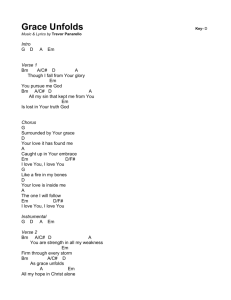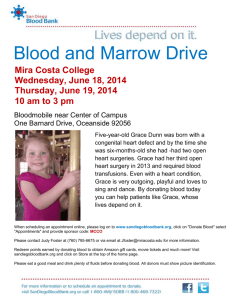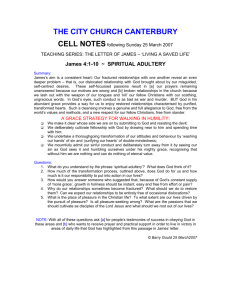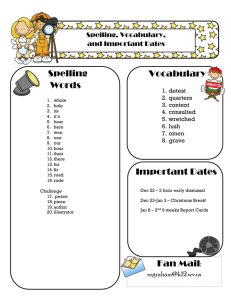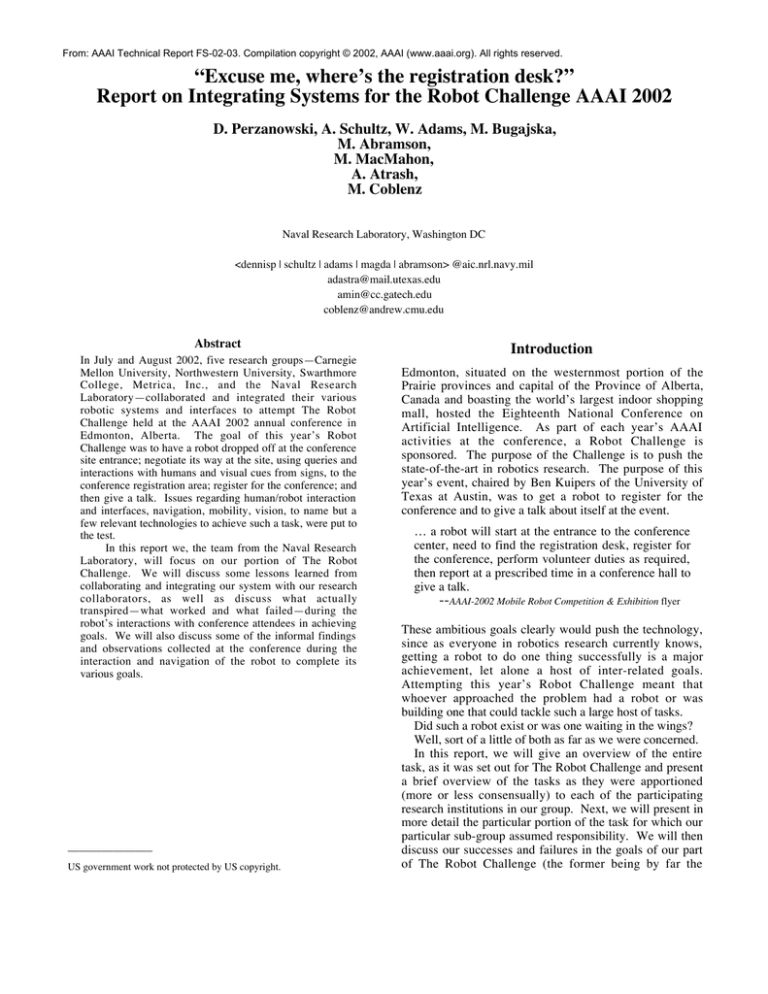
From: AAAI Technical Report FS-02-03. Compilation copyright © 2002, AAAI (www.aaai.org). All rights reserved.
“Excuse me, where’s the registration desk?”
Report on Integrating Systems for the Robot Challenge AAAI 2002
D. Perzanowski, A. Schultz, W. Adams, M. Bugajska,
M. Abramson,
M. MacMahon,
A. Atrash,
M. Coblenz
Naval Research Laboratory, Washington DC
<dennisp | schultz | adams | magda | abramson> @aic.nrl.navy.mil
adastra@mail.utexas.edu
amin@cc.gatech.edu
coblenz@andrew.cmu.edu
Abstract
In July and August 2002, five research groups—Carnegie
Mellon University, Northwestern University, Swarthmore
College, Metrica, Inc., and the Naval Research
Laboratory—collaborated and integrated their various
robotic systems and interfaces to attempt The Robot
Challenge held at the AAAI 2002 annual conference in
Edmonton, Alberta. The goal of this year’s Robot
Challenge was to have a robot dropped off at the conference
site entrance; negotiate its way at the site, using queries and
interactions with humans and visual cues from signs, to the
conference registration area; register for the conference; and
then give a talk. Issues regarding human/robot interaction
and interfaces, navigation, mobility, vision, to name but a
few relevant technologies to achieve such a task, were put to
the test.
In this report we, the team from the Naval Research
Laboratory, will focus on our portion of The Robot
Challenge. We will discuss some lessons learned from
collaborating and integrating our system with our research
collaborators, as well as discuss what actually
transpired—what worked and what failed—during the
robot’s interactions with conference attendees in achieving
goals. We will also discuss some of the informal findings
and observations collected at the conference during the
interaction and navigation of the robot to complete its
various goals.
_______________
US government work not protected by US copyright.
Introduction
Edmonton, situated on the westernmost portion of the
Prairie provinces and capital of the Province of Alberta,
Canada and boasting the world’s largest indoor shopping
mall, hosted the Eighteenth National Conference on
Artificial Intelligence. As part of each year’s AAAI
activities at the conference, a Robot Challenge is
sponsored. The purpose of the Challenge is to push the
state-of-the-art in robotics research. The purpose of this
year’s event, chaired by Ben Kuipers of the University of
Texas at Austin, was to get a robot to register for the
conference and to give a talk about itself at the event.
… a robot will start at the entrance to the conference
center, need to find the registration desk, register for
the conference, perform volunteer duties as required,
then report at a prescribed time in a conference hall to
give a talk.
--AAAI-2002 Mobile Robot Competition & Exhibition flyer
These ambitious goals clearly would push the technology,
since as everyone in robotics research currently knows,
getting a robot to do one thing successfully is a major
achievement, let alone a host of inter-related goals.
Attempting this year’s Robot Challenge meant that
whoever approached the problem had a robot or was
building one that could tackle such a large host of tasks.
Did such a robot exist or was one waiting in the wings?
Well, sort of a little of both as far as we were concerned.
In this report, we will give an overview of the entire
task, as it was set out for The Robot Challenge and present
a brief overview of the tasks as they were apportioned
(more or less consensually) to each of the participating
research institutions in our group. Next, we will present in
more detail the particular portion of the task for which our
particular sub-group assumed responsibility. We will then
discuss our successes and failures in the goals of our part
of The Robot Challenge (the former being by far the
shortest section of this report). Finally, we will present
some of the anecdotal lessons learned from our
participation in this event.
The Groups Organize
One of the groups to take on this year’s Robot Challenge
was a motley crew consisting of AI researchers, and
graduate and undergraduate students from several
institutions. Led by the indefatigable and undaunted Reid
Simmons (Carnegie Mellon University), Ian Horswill
(Northwestern University), Bruce Maxwell (Swarthmore
College), Bryn Wolfe (TRACLabs), and Alan Schultz
(Naval Research Laboratory), a collaboration of research
groups was formed.
It was their belief that an integrated robotic system could
be constructed to accomplish
all [timestamp: early April 2002]…
most [timestamp: late May 2002]…
many [timestamp: mid-June 2002]…
some [timestamp: 3 a.m. on July 31, 2002] of the goals
set forth in The Robot Challenge.
So what’s so hard about finding a registration
desk?
In a brief aside now, image the first time you ever
registered for a conference. You may have been in a
foreign or unknown city. If anything, the venue for the
conference was probably an unknown site. You probably
floundered around a bit trying to find your way. You may
have looked for some signs or asked an official-looking
individual at the center or a conference-attendee-type
where the registration desk was. If no satisfactory response
was obtained or you politely nodded that you understood
their mumbled or convoluted instructions and continued to
bumble around the center, you eventually found your way
and were able to register for this first most important event.
But look at what was involved in just these first few
steps in trying to find your way around an unknown
environment. These are some of the underlying
capabilities that our robot must exhibit, if it is to do
anything in this event.
Inside the venue, you looked for a sign. But in robotic
terms that involves machine vision. Wow! Bottleneck
number one. As a human, you are equipped with an
incredibly complex but efficient means for obtaining
visual. You have eyes and can look for signs, and then
once you find a sign, you can read it.
Well, let’s gloss over this vision problem, for the
moment, and let’s say that instead of trying to look for and
read a sign, let’s say you looked for an official-looking
person at the venue. What does an “official-looking”
person look like? The person is wearing a uniform, let’s
say. Pushing aside all of the problems of how a robot
“finds” or senses a human, let’s assume you know what a
person is and you don’t go walking up to a pillar to ask for
directions, you look for a human wearing a uniform. Think
of how much knowledge is necessary to encode the
concept of a uniform, which might be a standard uniform
for that site but is probably not a universal instance of what
a “uniform” is. Oh, the official at the site has a badge.
Well, now we’re back at the vision problem with having to
find and read signs. Let’s not do that loop again. Instead,
let’s rely on the kindness of strangers and just walk up to a
human and ask for directions.
If the person is wearing a conference badge, there’s a
good chance that they know where the registration desk is.
How else did they get their badge? Have someone else get
it for them? Steal one? But there’s that ugly vision
problem again—finding a sign, in this case a badge and
being able to read it.
So let’s just use tact here and come right out and ask
anything that resembles a human where the registration
desk is. And you get a response to your query!
However, did you have problems understanding the
human? Chances are you did. Especially if that person
doesn’t speak the same native language or dialect as you.
Another bottleneck for robotics emerges: the speech
recognition problem. But with repeated responses for
clarification or repetition where necessary, you do
eventually get the verbal instructions for the directions to
the registration desk. Next comes the task of navigating to
the goal.
Robotic navigation comes with its own set of problems:
sensors, localization, map adaptation, local versus global
navigation, etc. However, these problems are tractable and
you can manage to find your way to the registration area.
But now you have to get in the right line. That means
you have to read a sign, or ask. If your vision capabilities
are strong, you can read and get into the appropriate line,
or you can ask someone to point you in the right direction.
As a human, it’s pretty easy for you to know where the end
of a line is. As a human, you have already been socially
conditioned not to just barge right in to the front of a line,
but you find your way to the end of it and take your place,
perhaps interacting pleasantly with your nearest neighbor
as you wait your turn. After all, you do want to network.
Humans are pretty social and sociable creatures. We do
seem to organize in groups and we do congregate for
events and share refreshments and chit-chat. When given
the opportunity, they seem to like to converse with each
other about one thing or another. In the parlance, this is
called “schmoozing,” and some humans are better at it than
others, but robots have no concept of schmoozing
whatsoever. Given that schmoozing can focus on any
topic, it is quite a feat to get a robot to converse along one
topic of conversation and then jump to something else,
retrace conversational steps or go boldly off into a
schmoozing realm where no robot has ever gone before.
Given a very limited capability in this area currently, most
robots will stand politely silent or mouth Eliza-like
platitudes just to keep a human’s attention, waiting for the
next environmental input that prompts the firing of an
already programmed algorithm for action.
Moving up in line as fellow attendees peel off the queue,
you can eventually interact with the person behind the
desk, registering for the conference and politely asking
where to go to give your talk.
Again you must rely upon your navigational abilities to
find the location for your talk, but then once there you are
back on familiar territory—you have already prepared your
slides, you know your material, and you can deliver your
presentation, hopefully without any interruptions from the
audience. If you’re lucky, the only time you have to
interact with another human now, is during the questionand-answer period at the end of your presentation.
However, if the audience asks pointed questions about
specifics in your talk, you already have the knowledge to
answer and can provide an intelligent response.
The Birth of GRACE
In April 2002, our team convened for the first time and
began tackling the problem. Somewhere along the line
(off-line or on-line) a name emerged for the robot entity
they were creating, GRACE (Graduate Robot Attending
ConferencE) [Figure 1].
Figure 1. Amazing GRACE
GRACE, “a B21R Mobile Robot built by RW, has an
expressive face on a panning platform as well as a large
array of sensors. The sensors include a microphone, touch
sensors, infrared sensors, sonar sensors, a scanning laser
range finder, a stereo camera head on a pan-tilt unit, and a
single color camera with pan-tilt-zoom capability. GRACE
can speak using a high-quality speech synthesizer, and
understand responses using her microphone and speech
recognition software”1.
The group analyzed the task of registering for a
conference and giving a talk. They basically saw it as a
five-part process. (A similar breakdown and participation
of the event is offered at our website summarizing the
event. See Note 1.) The first part was getting the
directions, and navigating to the conference registration
area. (Getting directions and navigating to the room for
presentation was considered another incarnation of this
task). The second part was navigating to the desk itself.
The third part was negotiating the line for registration. The
fourth was the actual act of registering (this could actually
be considered similar to the first part, but we separated it
for expositional purposes). Finally, the fifth part was
presenting a talk at the conference. As each part of the
entire process of registering for the conference and giving
the talk were analyzed, we noticed that various member
research institutions could tackle certain parts of the larger
task more appropriately than others. Each institution had
its own research strengths, and utilizing these strengths
became the keystone for building the final integrated
system to accomplish The Robot Challenge.
Thus, the Carnegie Mellon University (CMU) research
team concentrated their efforts on navigational skills.
Based on their work in navigation, CMU handled basic
navigation and the ability to detect and negotiate riding an
elevator at the conference center. CMU also assumed the
research responsibility of getting GRACE to stand in line
(Nakauchi and Simmons 2002), converse with the registrar
and register, navigate to the assigned location for her talk,
and express herself to humans via an onscreen image of her
face (Bruce, Nourbakhsh, and Simmons 2002).
For GRACE’s ability to communicate with humans, the
Naval Research Laboratory (NRL) relied on its work in
human-robot interaction (Perzanowski et al. 2002;
Perzanowski, Schultz, and Adams 1998) and provided the
human-robot interface that permitted spoken natural
language and natural gestures. With this interface, a
human could give the robot directions verbally, as well as
point in the right direction for any of the locations desired.
Furthermore, the interface allowed for clarifications and
corroborations of information. Thus, for example, if an
utterance was unclear, GRACE could indicate this by
saying “What?” or when presented with a particular goal,
GRACE could ask “Am I at the registration desk?”
Furthermore, if the human told GRACE to turn left, for
example, but then pointed to the right, GRACE could
complain, “You told me to turn left but pointed right.
What do you want me to do?”
GRACE was also outfitted with a Personal Digital
Assistant (PDA). NRL has been using a wireless PDA
along with its natural language interface to provide
gestures [Figure 2].
Figure 2. Wireless Personal Digital Assistant with stylus
Based on the information obtained from the environment,
NRL’s PDA interface builds up a localized map which is
displayed as a touch screen on the PDA. With it, users can
provide gestural input: a set of x,y coordinates on a map
with an utterance such as “Go over here” or “Follow this
path” accompanied by a line drawn on the map, or “Go to
this doorway” accompanied by a stylus tapping on an x,y
location on the map. Natural gestures are sensed by high
resolution rangefinders and were to be seen by stereo
cameras, but these capabilities were not available in time
for GRACE’s performance.
So, our PDA interface was revised to sweeping gestures
using a stylus on the PDA touch screen to indicate left and
right directions. Unfortunately, due to programmer errors
before the event, the device was rendered inoperable for
the Challenge. For the record, we did have this device
coded up and tested, but our current hypothesis about the
failure is that the process talking to it was never started.
For the people-tracking parts of the task and for locating
faces, TRACLabs provided a vision sensor and appropriate
controllers. However, given the various other sensors and
controllers that were already installed on GRACE, these
were disabled on site.
Swarthmore’s work on vision and recognition using
OCR was utilized to locate and interpret signs and badges,
as well as to implement visual servoing capabilities used to
approach the registration desk. Northwestern provided a
software package that generates a verbal presentation with
accompanying PowerPoint slides generated by plugging
together canned text strings it obtains from a database.
NRL under the Gun
In the remainder of this report, we will concentrate on
NRL’s portion of The Robot Challenge; namely, getting
GRACE from the entrance of the conference center to the
registration area.
GRACE was not allowed to have any prior knowledge of
the layout of the conference center but was allowed general
knowledge about conference centers; for example, they
may consist of multiple floors and if so, there are typically
three ways to get between them: stairs, escalator, and
elevator. With this information we immediately started
working on getting GRACE to understand all of the
navigation and directional issues involved in getting
downstairs via an elevator.
Since GRACE cannot navigate stairs or escalators, our
options for getting to the goal were mercifully limited. We
knew further that we had to navigate down inside the
conference center. All of this basically helped us ensure
that our grammars and dictionaries would handle likely
human-robot interactions.
GRACE was supposed to find the registration area
through interactions with humans. She could have scoured
the crowd for an official, but then we had the problem of
trying to figure out what an official might look like. So,
we rejected that option outright. Next, we considered the
possibility of GRACE’s scouring the entrance area for a
conference badge and then interacting with the badge
holder to get directions to the registration area. But at the
time, when we were considering this option, some of the
later available software was still in beta-testing, so we
optioned for a different interaction initially.
GRACE was going to scour the area for a human—she
could do that given the sensors and functionalities of the
other modules being provided by our co-researchers. She
was then going to interact with whomever she saw and get
as much information out of this informant as possible. She
would follow the instructions given to her, and if she
managed to find the area from this one interaction, the goal
would be achieved. If more information was needed, she
would then go to another human and interact accordingly.
All of this sounded very nice and normal to us. That’s
basically what people do. However, for verbal interactions
with our robots back at NRL, we had been using an off-theshelf speech recognition product. Granted, it had been
honed and fine tuned via a Speech Development Kit, so its
recognition rate for its limited vocabulary and grammatical
constructions was extremely high. While we have no
quantified data to support this claim, our general feeling
and the feeling of people using this modality to interact
with our robots back in the lab was that the speech
recognition device we were using was pretty impressive.
Human users felt comfortable interacting with the robots in
our lab using speech, and they didn’t seem overly
frustrated with poor recognition of utterances.
While we felt pretty confident about the speech
recognition device we were using, we were still not
confident enough to let it ride unbridled at the conference.
After all, it had been trained on one researcher’s voice:
male; exhibiting a standard US English dialect (if there is
such an animal). And it worked in the lab with other males
exhibiting dialects tolerably close to whatever dialect it
was that the trainer provided. However, we feared we
might have problems if a female were to be chosen by
GRACE to interact with. We could have trained GRACE
with a female trainer as well, but then we would have had
to provide a switch in the recognition engine which would
load the appropriate models. All of this, while do-able,
wasn’t done. Other matters came up. It was pushed on the
stack, and didn’t get to pop.
Furthermore, if anyone had a slight accent, the speech
recognition engine would have problems. We also worried
about paraphrasability. After all, who said “How many
ways do I love thee?” We started sweating about the
myriad of different ways somebody might tell GRACE to
do something. While the prototype grammars and
dictionaries that were provided to GRACE had been
worked on for many years in our lab, and are therefore
rather robust in being able to capture a great deal of the
richness of language, we tended to shy on the side of
conservatism and decided to have GRACE interact with
one of us who was fairly familiar with GRACE’s linguistic
capabilities, as rich as they might be. We knew she could
handle a great deal of paraphrasability: that’s one of the
strengths of the semantic component of our natural
language understanding system, Nautilus (Wauchope 1994;
Perzanowski et al. 2001). However, we just didn’t want to
take the chance of putting it to the test in a very
conversational environment with a complete stranger, far
beyond what it had ever been exposed to. Furthermore,
since this was the initial step of a long registration task
with plenty of other places to go wrong and our team
members relying on a competent (and successful) first step,
we, therefore, opted to have GRACE interact with one of
our own team members who was fairly familiar with
GRACE’s linguistic capabilities and fairly comfortable
with the speech hardware in general.
Given the ability to interact verbally, GRACE also
needed the ability to detect the presence and location of
humans. This information was provided by one of our
team members, CMU. However, we had already built in a
gesture-detection component into our human-robot
interface, and we utilized it here in order to disambiguate
any speech that required some kind of gesture to
accompany it. For example, if the human said “Grace, it’s
over there,” but didn’t point to any location in the real
world, GRACE is capable of asking for additional
information, or at least complaining that something is
amiss by asking “Where?” Likewise, GRACE can detect
inconsistencies in verbal and gestural input, as, for
example, if a person says “Grace, turn left” but points
right, GRACE will complain, “I’m sorry, you told me to
turn one way, but pointed in another direction. What do
you want me to do?”
These were capabilities that we brought to the drawing
board with us. However, what we needed to do for The
Challenge was to integrate our capabilities (expand them
where necessary) and the capabilities and modules of other
systems from our co-researchers’ efforts and create a
unified system.
For our portion of the task, we created a module
written using TDL libraries. Our module interacts with
other modules through an IPC interface which was
developed specifically for The Challenge. Our task
module therefore interacts with the other modules of
GRACE’s architecture, such as mobility, and object
recognition and the facial module displaying GRACE’s
facial expressions and movements on the computer screen,
as in Figure 3.
Figure 3. Interaction of various modules
Our task module, Figure 4, interleaves linguistic and visual
information with direction execution. Given a specific
destination to be reached, such as a registration area, the
task module interleaves the information gathering with
direction execution.
Figure 4. NRL Task Module
The module allows for a priori knowledge in the form of a
destination. For GRACE this was the registration desk. If
there are no directions to be followed, GRACE performs a
random walk until a human is detected. Once a human is
found, she starts a conversation, the goal of which is to
obtain the directions to the destination in question. The
directions can include simple commands such as “Turn
left,” “Go forward five meters,” as well as higher level
instructions such as “Take the elevator,” or “Turn left next
to the Starbucks.” Once a list of directions is complete,
they are executed on the beginning of next iteration of the
control loop. The task is completed once the destination is
reached, as determined by an explicit human confirmation
or perception of the goal.
Parallel to this loop, there are a number of monitors
running; for example, an explicit “STOP” command can be
issued if unforeseen or dangerous conditions arise;
perception processing occurs, allowing the detection of the
destination or a human.
The directions obtained during the information-gathering
stage of the task are associated with a specific destination.
They are executed sequentially in the order in which they
were given by the human.
There are two types of direction that can be given. First,
there is a simple action command, such as “Turn left.” We
assume that in order to get to the destination, GRACE
should execute this command before executing the next
instruction. The second type of command is an instruction
specifying an intermediate destination, such as “Take the
elevator to the second floor.” In this case, a new
intermediate goal is instantiated (the elevator), and the
logic is recursively applied to the new goal. Once all the
available directions have been executed and successfully
completed, GRACE can conclude that she has either
arrived at the destination or additional information is
required to reach the goal. If GRACE perceives the
destination before all the directions are executed, the
remaining ones are abandoned, and she continues with the
next goal.
Thus, if GRACE asks a human bystander, “Excuse me,
where is the registration desk,” and the human responds,
“Grace, to get to the registration desk, go over there
<accompanied by a gesture>, take the elevator to the
ground floor, turn right, and go forward fifty meters,” in
terms of our module as described here, the human’s input
is mapped to a representation something like the following:
institutions of our team. On the day of The Robot
Challenge, GRACE took her place at the entrance to the
conference site.
The site chosen for GRACE’s entrance was two flights
above the conference registration level. As shown in
Figure 5, GRACE’s task would require that she navigate
from the upper right-hand portion of the photo to the lower
portion of the building. This would require that she find
out from one of the bystanders how to get down to the
lower level.
The dialog for this part of the task basically was as
follows:
START
FINISH
Figure 5. Exterior View of Shaw Convention Centre,
Edmonton
GRACE: Excuse me, could you tell me how to get to the
registration desk?
Human: Grace, take the elevator down two flights.
GRACE: Where is the elevator?
Human: It’s over there <accompanying gesture>.
See Figure 6.
Find Registration Desk:
Find Elevator (ground floor);
Go over there <gesture>;
Turn right;
Go forward 50 meters.
GRACE in the Spotlight
With our system as outlined in the previous section, we
worked on integrating it with the other components
provided by our co-workers from the other member
Figure 6. GRACE and Human (on left) interact and
negotiate boarding the elevator (out of sight on right)
The above dialog basically characterizes the initial
interchange between GRACE and our researcher chosen to
interact with her.
Because we knew beforehand that our speech
recognition software and hardware would have some
difficulty in this environment, we asked the management of
the conference center to turn off a rather lovely but noisy
waterfall that ran alongside the elevator, escalators and
stairs, and cascaded down from the street level where
GRACE started to the conference level two floors below,
Figure 7.
Figure 7. Top-view inside elevator looking down to
registration level with waterfalls to either side; escalator and
stairs on right
After the initial dialog, GRACE had some difficulty
navigating the passageway onto the elevator, but she
succeeded, and asked for manual assistance pressing the
correct button down to the appropriate level (GRACE does
not have manual capabilities at this time).
GRACE’s ability to detect the elevator, both in getting
on and off using Carnegie Mellon University’s elevatordetecting algorithms was quite impressive, Figure 8.
gestures from the PDA were not working as expected, the
human seemed to have become frustrated. This caused the
speech software to have difficulty, and GRACE had
trouble understanding the human. Tension and stress in the
human voice can cause many state-of-the-art speech
recognition systems to experience problems. This is
precisely what happened at this point in GRACE’s journey.
After a few tense moments of misunderstood
communication, both GRACE and the human managed to
navigate the passageway, and she was able to turn a couple
of corners, walk several meters forward and turn to face the
registration area and desk, Figure 9.
Figure 9. GRACE (center behind Human) arrives at the
registration area
At this point, our task was ended. We had managed to
assist GRACE in navigating from an area two flights
above, onto an elevator, and down to the registration area.
It was now our team member’s task to get GRACE to
register and then find her pre-assigned room to give her
talk.
While our task was over, suffice it to say here that
GRACE did indeed register for the conference. She
managed to find the appropriate line to stand in, Figure 10.
Figure 8. View of closed elevator doors
Once down on the conference level and off the elevator,
GRACE had some problems negotiating her way through a
narrow L-shaped passageway from the elevator onto the
main concourse level. The human accompanying her at
this point tried to use natural language and gestures to
navigate through the narrow area. GRACE was basically
told to turn left or right or go straight ahead, and gestures
accompanied the commands where appropriate. However,
because she was having navigation problems and the
Figure 10. GRACE rehearses reading “Robots” and
registering for conference
She read the correct sign that was for “ROBOTS,” using
software developed by the Swarthmore team, but perhaps
in robotic enthusiasm, she rudely barged into the line of
people waiting to be registered, who were actually judges
for the event, instead of politely taking her place at the end
of the line.
After interacting with the registration booth personnel,
GRACE navigated to the conference exhibit hall where she
first stopped to visit a vendor’s booth, then continued to the
bleachers at the rear of the hall where she gave her
presentation, using a program designed by Northwestern
University, Figure 11.
Figure 11. GRACE (foreground right with back to camera)
delivers talk at AAAI 2002. Audience members view large
screen above right (out of view) of PowerPoint presentation
She eventually received several awards:
The
Technology Integration Award, The Human-Computer
Interaction Award, and The Award for Robustness in
Recovery from Action and Localization Errors. Everyone
attending found the latter award rather humorous and
perversely appropriate, given GRACE’s somewhat rude
behavior in the registration line.
The Morning After
From our point of view and the tasks we were responsible
for attempting and completing, two basic lessons-learned
emerged in hindsight:
1. The hardest part of this task was obtaining
unambiguous directions to the registration area.
Great care had to be taken in the design of the
system to make sure that in conversation with the
human, GRACE would ask questions that
produced clear, simple directions, but still facilitate
fairly robust and flexible conversation.
2. While a general planner to tackle our part of the
task was designed, a more robust general planner is
desirable, especially one that can handle more
cases and one that can provide the robot with more
behaviors.
The Gloriously Optimistic Future
Given our experiences with our portion of The Robot
Challenge we are currently underway investigating some
improvements to GRACE’s architecture.
Our research at NRL in natural language and gesture has
thus far involved writing robust grammars that can
withstand a great deal of paraphrasing. However, it is next
to impossible to predict the richness and complexity of
human speech and interaction with just a phrase structure
grammar and pre-defined lexical items. In a sense,
therefore, we have been shooting with one hand tied behind
our backs. Our one gun has been loaded with a natural
language understanding system that can interpret what is
being said, but we also need a natural language system that
is robust enough to parse larger elements, namely a dialog,
so that the unpredictable nature (as well as the predictable
nature) (Grosz and Sidner 1986; Grosz, Hunsberger and
Kraus 1999) of human conversation and interaction can be
captured. In terms of speech recognition, we await this
community’s accomplishments in developing robust
systems capable of handling speech in noisy environments,
as well as with true cross-speaker capabilities. We are
currently working with Sphinx (Huang et al. 1993) to
create a speech recognition system that does not have to be
trained and to develop grammars capable of handling novel
utterances. Further, to achieve some of these goals we will
interleave some stochastic parsing at the dialog level, since
we believe this information can help in disambiguating
some utterances and ultimately provide for more robust
natural language parsing and full semantic interpretation of
utterances.
In terms of our desire to incorporate more general
planning into our architecture, we are working on one
based more on probabilistic reasoning (Likhachev and
Arkin 2001), rather than the more-or-less finite state
machine we utilized in this year’s Robot Challenge.
Finally, we assume that human interaction is facilitated
by each individual in the interaction having a similar or
comparable cognitive model of the interaction. Since
human behavior can be characterized and modeled, and
because we believe this behavior can be used as a model of
behavior in robots that interact with humans, we are
investigating ways of incorporating a cognitive model for
human-robot interaction written in ACT-R (Anderson and
Lebiere 1998).
Some Additional Thoughts
The following are some additional thoughts gleaned from
comments of our team members about their work and
participation in The Robot Challenge.
When asked what the researchers thought was the
hardest part of his or her task, one team member said that
the building of our architecture for the task was complex
because we were dealing with constantly evolving building
blocks.! Furthermore, the TDL language, control-level
robot skills, and interfaces and predicted abilities of
other software modules were constantly in flux. Another
team member said that the hardest part was exploring all
possible cases the robot might encounter, and all possible
paths through the decision space. Since we used a finite
state machine to navigate through the decision space, we
need to think about ways to avoid hard-coding a finite state
machine and do it a bit more intelligently. Finite state
machines get big quickly, and it's very difficult to be sure
that the whole thing works. All states really need to be
tested, but in a large system this is infeasible and
impractical. This line of thinking parallels our earlier
conclusion that probabilistic reasoning and cognitive
modeling might help us around this issue.
When dealing with a large number of people at different
sites, we ran into the problem of inconsistent data types
and divergent naming schemes.
This can prove
problematic and frustrating for team work at any one site,
and particularly for the group as a whole.
In terms of lessons learned, the team members agreed
that when one works closely with others, it is paramount to
make sure that goals and interfaces are defined correctly
the first time. To this end documentation certainly helps.
Also, teams desiring to integrate their components with
others should test them and the integration as far ahead of
time as possible.
Since we dealt with human-robot
interactions and an interface, it is important to keep the
naïve user in mind. Likewise, it was noted that at the event
GRACE’s verbal reactions were hard to understand. It is,
therefore, important to have a speech generation
component that is both easy to hear and understand.
Feedback to the human user is important for an easy to
use interface. In the event, GRACE did not give feedback
when aborting a movement and retrying the action;
therefore, some of her actions were difficult to interpret.
Likewise, as we mentioned earlier, a PDA interface failed
to operate; however, no indication of the failure was given
to the human user. Consequently, during GRACE’s actual
performance, the human user did not know why his PDA
gestures were failing. In the event, GRACE did not
give feedback when aborting a movement before its
intended finish or retrying the action. However, GRACE
constantly asked for feedback at the completion of actions:
“Have I made it to the goal?” This was our way of
determining that GRACE was finished completing an
action or set of actions. However, to by-standers this
repeated query made GRACE look dumber than she was.
Designers of interfaces, therefore, must ensure that all
interactions, including error-catching strategies appear
“normal” and natural.
Acknowledgments
The research for this report was partly funded by the Office
of Naval Research (N0001401WX40001) and the Defense
Advanced Research Projects Agency, Information
Processing Technology Office, Mobile Autonomous
Robotic Software project (MIPR 02-L697-00).
Graphics and Photo Credits
The authors wish to thank the following for providing us
with a photo record of the 2002 Robot Challenge: Figure
1, The City of Edmonton, Alberta, Canada; Figure 2,
William Adams of the Naval Research Laboratory; Figures
3 and 4, Magda Bugajska of the Naval Research
Laboratory; Figures 5-11, Adam Goode of Carnegie
Mellon University.
General Thanks and a Disclaimer
The primary author of the paper would like to thank
everyone on the team in working on AAAI 2002 Robot
Challenge. He would also like to thank the NRL group for
its cooperation and hard work in getting its portion of the
task done for the event. In terms of this report, the primary
author accepts full responsibility for any errors of omission
or commission regarding the material contained herein.
Note
1. “GRACE: The Social Robot,”
http://www.palantir.swarthmore.edu/GRACE.
References
Anderson, J. R. and Lebiere, C. 1998. The Atomic
Components of Thought. Lawrence Erlbaum: Mahwah,
NJ.
Bruce, A., Nourbakhsh, I., and Simmons, R. 2002. “The
Role of Expressiveness and Attention in Human-Robot
Interaction,” Proceedings of the IEEE International
Conference on Robotics and Automation, Washington
DC, May 2002.
Grosz, B. and Sidner, C. 1986. “Attention, Intentions, and
the Structure of Discourse,” Computational Linguistics,
12:3, pp. 175-204.
Grosz, B., Hunsberger, L., and Kraus, S. 1999. “Planning
and Acting Together,” AI Magazine, 20:4, pp. 23-34.
Huang, X.D., Alleva, F., Hon, H.W., Hwang, M.Y., Lee,
K.F., and Rosenfeld R. 1993. “The SPHINX-II SpeechRecognition System: An Overview.” Computer Speech,
and Language, 7:2, pp. 137-148.
Likhachev, M., and Arkin, R.C. 2001. “Spatio-Temporal
Case-Based Reasoning for Behavioral Selection.” In
Proceedings of the 2001 IEEE International Conference
on Robotics and Automation, (May 2001), pp. 16271634.
Nakauchi, Y. and Simmons, R. 2002. “A Social Robot that
Stands in Line,” Autonomous Robots. (May 2002), 12:3,
pp. 313-324.
Perzanowski, D., Schultz, A.C., Adams, W., Skubic, M.,
Abramson, M., Bugajska, M., Marsh, E., Trafton, J.G.,
and Brock, D. 2002. “Communicating with Teams of
Cooperative Robots,” Multi-Robot Systems: From
Swarms to Intelligent Automata, A. C. Schultz and L.E.
Parker (eds.), Kluwer: Dordrecht, The Netherlands, pp.
185-193.
Perzanowski, D., Schultz, A.C., Adams, W., Marsh, E., and
Bugajska, M. 2001, “Building a Multimodal HumanRobot Interface.” In IEEE Intelligent Systems, IEEE:
Piscataway, NJ, pp. 16-21.
Perzanowski, D., Schultz, A.A., and Adams, W. 1998.
“Integrating Natural Language and Gesture in a Robotics
Domain.” In Proceedings of the International
Symposium on Intelligent Control, IEEE: Piscataway,
NJ, pp. 247-252.
Wauchope, K. (1994) Eucalyptus: Integrating Natural
Language Input with a Graphical User Interface, tech.
Report NRL/FR/5510-94-9711, Naval Research
Laboratory: Washington, DC.


